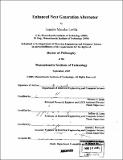| dc.contributor.advisor | Thomas A. Keim, Jeffrey H. Lang and David J. Perreault. | en_US |
| dc.contributor.author | Lorilla, Leandro M. (Leandro Manalac), 1977- | en_US |
| dc.contributor.other | Massachusetts Institute of Technology. Dept. of Electrical Engineering and Computer Science. | en_US |
| dc.date.accessioned | 2006-11-07T12:26:12Z | |
| dc.date.available | 2006-11-07T12:26:12Z | |
| dc.date.copyright | 2005 | en_US |
| dc.date.issued | 2005 | en_US |
| dc.identifier.uri | http://hdl.handle.net/1721.1/34474 | |
| dc.description | Thesis (Ph. D.)--Massachusetts Institute of Technology, Dept. of Electrical Engineering and Computer Science, 2005. | en_US |
| dc.description | Includes bibliographical references (p. 173-176). | en_US |
| dc.description.abstract | The power requirements of automotive alternators are increasing significantly due to the introduction of new vehicle electrical loads. Moreover, the possible transition to a 42 V electrical system is introducing new concerns regarding the load dump overvoltage transient of alternators. This thesis makes several contributions to the power density, efficiency, and transient performance of future alternators. A comparison and design optimization of four alternator types is conducted to identify the least cost alternator that meets the challenging requirements of future automobiles. Alternator designs with conventional diode rectifiers and switched-mode rectifiers are investigated. It is found that optimized Lundell alternators are capable of meeting the demands of future systems, and that wound field synchronous machines may also be competitive. It is also found that incorporation of a simple switched-mode rectifier enables substantial improvements in designs optimized for their use. The behavior of the Lundell alternator under load dump transient conditions is studied. It is found that rotor eddy currents limit the rate at which the machine can be de-excited to terminate the transient overvoltage. Models for the de-excitation process are developed based on experimental measurements, and new field control circuits are proposed that provide fast field de-excitation. | en_US |
| dc.description.abstract | (cont.) The use of foil field windings in Lundell alternators to improve alternator power density is also explored. Foil field windings are shown to provide higher conductor packing factors than conventional wire wound fields (e.g. 73% as opposed to 64% for a typical wire wound design) and offer improved thermal transfer properties. These advantages are demonstrated to enable significant increases in field ampere turns and achievable alternator output power. However, realizing these advantages requires new field excitation circuits that can deliver high field currents at low voltages, without exceeding the limited current ratings of alternator brushes. Two new field excitation circuits capable of meeting the needs of foil field windings are developed and experimentally demonstrated. The first field excitation circuit is based on the use of a coreless printed circuit board transformer with a rotating secondary for contactless transfer of power to the rotor. A stationary inverter delivers high frequency ac to the transformer primary, and the power received by the transformer secondary is rectified and delivered to the field. This approach eliminates the need for brushes, and their associated wear and current limitations. | en_US |
| dc.description.abstract | (cont.) This rotating transformer topology is designed, built and tested at standstill with a foil wound bobbin. Experimental results demonstrate that a 51% increase in ampere turns on the rotor can be delivered with this approach, which is more than sufficient for practical applications. The second class of field excitation circuits developed in this thesis uses a DC/DC converter on the rotating side to provide a step down in voltage and a step up in current for the foil field. Control information is communicated to the rotating converter to regulate the field. An experimental alternator implementing a foil field winding and this excitation circuit is developed and experimentally validated. Tests at idle speed demonstrate an improvement of 15% in alternator output power, and an approximate increase of 30% in field ampere turns for similar temperature limits. It is anticipated that significantly larger power improvements could be achieved if the alternator stator were redesigned to take advantage of this improved field capability. | en_US |
| dc.description.statementofresponsibility | by Leandro Manalac Lorilla. | en_US |
| dc.format.extent | 278 p. | en_US |
| dc.format.extent | 12233403 bytes | |
| dc.format.extent | 12246777 bytes | |
| dc.format.mimetype | application/pdf | |
| dc.format.mimetype | application/pdf | |
| dc.language.iso | eng | en_US |
| dc.publisher | Massachusetts Institute of Technology | en_US |
| dc.rights | M.I.T. theses are protected by copyright. They may be viewed from this source for any purpose, but reproduction or distribution in any format is prohibited without written permission. See provided URL for inquiries about permission. | en_US |
| dc.rights.uri | http://dspace.mit.edu/handle/1721.1/7582 | |
| dc.subject | Electrical Engineering and Computer Science. | en_US |
| dc.title | Enhanced next generation alternator | en_US |
| dc.type | Thesis | en_US |
| dc.description.degree | Ph.D. | en_US |
| dc.contributor.department | Massachusetts Institute of Technology. Department of Electrical Engineering and Computer Science | |
| dc.identifier.oclc | 70720734 | en_US |
